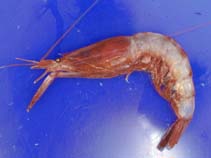Pasiphaea multidentata Esmark, 1866
Pink glass shrimp
Classification / Names Common names | Synonyms | CoL | ITIS | WoRMS
Malacostraca | Decapoda | Pasiphaeidae
Environment: milieu / climate zone / depth range / distribution range Ecology
Bathypelagic; depth range 10 - 2000 m (Ref. 8126), usually 400 - 400 m. Subtropical; 76°N - 16°N, 75°W - 37°E
Distribution Countries | FAO areas | Ecosystems | Occurrences | Introductions
Arctic, Atlantic Ocean and the Mediterranean: from Boothia Peninsula, Canada to Mauritania, east to the Mediterranean.
Length at first maturity / Size / Weight / Age
Maturity: Lm ? range ? - ? cm Max length : 10.5 cm TL male/unsexed; (Ref. 8136); 4.54 cm CL (female)
Benthopelagic. Juveniles carry out actual vertical migrations while adults undertake epibenthic movements along the bottom (Ref. 105772). Found in the continental shelf (Refs. 79119, 78232), upper and middle slope (Refs. 78232, 105341). Predatory activity occurs higher in the water column at night. Bases its diet on mesopelagic fishes and juvenile cephalopods, decapods, and euphausiids. However nocturnal diet is observed and includes gammarid amphipods, isopods, and macruran decapods (Ref. 105773).
Life cycle and mating behavior Maturity | Reproduction | Spawning | Eggs | Fecundity | Larvae
Members of the order Decapoda are mostly gonochoric. Mating behavior: Precopulatory courtship ritual is common (through olfactory and tactile cues); usually indirect sperm transfer.
Main reference
References | Coordinator | Collaborators
Hayashi, K.-I. 2006. (Ref. 8126)
IUCN Red List Status (Ref. 130435)
CITES status (Ref. 108899)
Not Evaluated
CMS (Ref. 116361)
Not Evaluated
Threat to humans
Human uses
Fisheries: commercial
| FishSource |
Tools
More information
Internet sources
BHL | BOLD Systems | CISTI | DiscoverLife | FAO(Publication : search) | Fishipedia | GenBank (genome, nucleotide) | GloBI | Gomexsi | Google Books | Google Scholar | Google | PubMed | Tree of Life | Wikipedia (Go, Search) | Zoological Record
Estimates based on models
Price category
(Ref. 80766):
Unknown.



